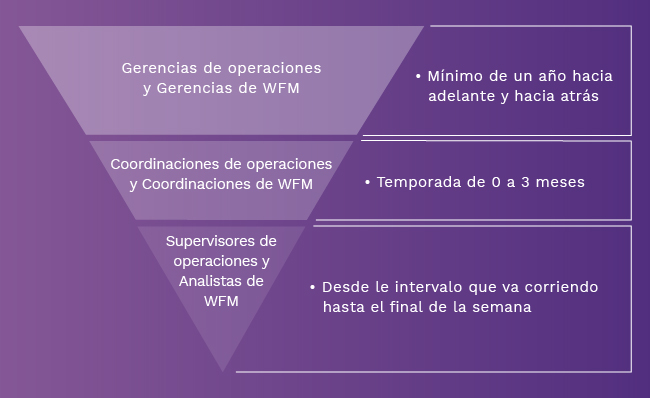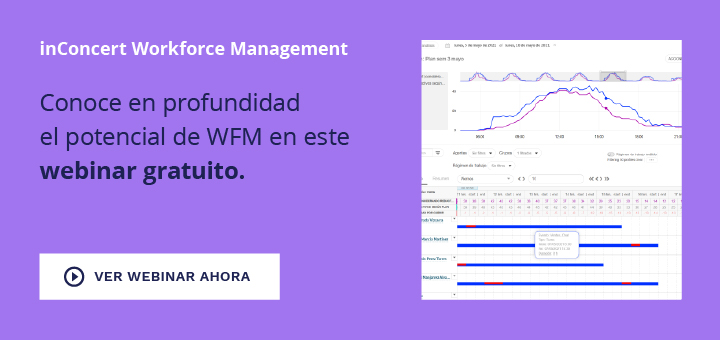The analysis of information is one of the most complex processes of all that it entails Workforce Management (WFM). At the same time, it is one of the least valued by contact centers. Generally, analysis is identified only as the organization of databases and the presentation of information through line graphs, bar charts, pie charts and – the most daring – scatter plots.
However, it is much more than that. The process of information sorting and analysis is the heart, the raison d’être of any WFM process.. Without analytics, it would not be possible to develop key inputs to feed other processes, such as the creation of intraday distributions or invoice projection.
A pesar de ser un proceso tan crítico, Most contact centers do not give it the importance it deserves. Tasks such as tracking short, medium, and long term indicators; reporting and real-time monitoring are usually carried out under the premise of contract compliance, rather than the criticality of the process and the importance of continuous improvement.

Analytics and WFM: data tells stories
In the context of contact centers, the information generated by the WFM team is commonly used to explain the results of the indicators. But this process can do much more: it can help to leave the scenario of “Chronicle of a death foretold” in the past.
The first aspect to understand about information analysis is that it always depends on the target audience.
There are three main hierarchical levels in any organization:
1. Strategic level: It is in charge of long-term plans. It consumes information to develop strategies, discover markets, predict possible futures and seek new business opportunities.
2. Tactical level: Manages short and medium term plans. The information is used to carry out continuous improvement programs, review customer behavior, intraday variation according to seasonality, among others.
3. Operational level: Responsible for fulfilling short-term plans, generally oriented to results, maintenance of service levels, abandonment levels, occupancy, among others.

The source of a piece of data can be the same, but the way the data is presented will depend on the effect you want to achieve at the hierarchical level. It is not the same to say that 90% of scheduled hours are being met, as it is to say that there is a 10% absenteeism. The latter statement may cause alarm, while the former may leave a one-time absenteeism problem unnoticed.
The second important aspect to improve data analysis is to understand that you must always have fresh information. In the past, you used to work with manual processes that required a lot of operational time and left no room for analysis time. Nowadays, dedicated WFM tools employ technology that allows information to be sorted and presented in the required form in the shortest time. With additional advantages such as improved human utilization.
Advantages of using analytics tools in WFM: more accuracy in less time
There are multiple benefits that WFM analysts can gain by implementing data analytics tools. The first is the time reduction. In addition, there is a positive impact on the quality of data organization and interpretation.
The reduction of human errors and the elimination of manual or routine processes. is the golden dream of every WFM team. Being able to go from performing five or six different steps in an Excel file, to refreshing a view to take a screenshot with the final data is an advance that every contact center should consider as a priority. This time saved could be invested in training, so that the WFM team can go from generating data to interpreting it and making decisions based on it. A human talent will always generate more value than one that only performs routine tasks.
WFM tools usually contain libraries and algorithms to perform complex statistical calculations and correlations between variables that would not be possible with empirical methods. This feature not only provides a time-saving advantage, but also in the generation of valuable information for decision making at all levels of the organization.
Finding unexpected relationships between different variables opens the way to questions that can generate answers to problems hidden in indicators commonly analyzed through simple averages.
Some issues when analyzing the information in WFM
Despite all these benefits, it is always prudent to ask other questions regarding this process. The fundamental question should be: Does all the information we are generating and working with add value to the objectives of the process?
It is common to receive constant requests to add a new indicator to the daily reports in WFM, or to have quick calculations on hand for unplanned meetings. However, it is useful to ask how much of that information is actually used at all levels. This brings us to the second question: how much information is needed to make decisions?
In conclusion, there is no right answer, it will depend on each particular case. What is really important is the level of understanding of the information at hand. You can count on the best WFM software, with the dashboard The most complete and personalized indicators that can be obtained; but there is no magic algorithm if you do not have the knowledge to interpret the information and use it to obtain better results.
Learn more about inConcert WFM and how it can help you control your operation in real time.




